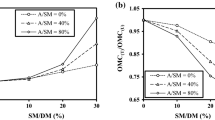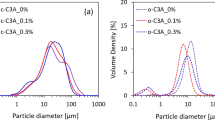Abstract
Since many polymer–organoclays nanocomposites are prepared in melt state, the thermal stability of the surfactants present in these organoclays is extremely important. Alkyl ammonium salts are surfactants which have been used in organoclays, but the low thermal degradation temperature of these salts is a drawback for polymer nanocomposites preparation in the melt state at temperatures higher than 200 °C. In order to obtain organoclays more suitable to be used in these polymer nanocomposites, in this work clay minerals were modified with more thermally stable organic modifiers than conventional salts. Two types of commercial clay minerals were organically modified with alkyl ammonium salt, alkyl and aryl phosphonium salts and an organosilane compound. X-ray diffraction, thermogravimetric analysis (TG) and infrared analysis results indicate that for both commercial clay minerals the preparation of the organoclays was efficient. TG analysis confirmed that phosphonium and silane organoclays are more thermally stable as compared with conventional alkyl ammonium organoclays. It was also observed that the thermal resistance of the organoclay depends on the type of the aluminosilicate used for the organic modification.








Similar content being viewed by others
References
Grim RE. Clay mineralogy. New York: McGraw-Hill; 1968.
Alther GR. Organically modified clay removes oil from water. Waste Manag. 1995;15:623–8.
Xu SH, Sheng G, Boyd SA. Use of organoclays in pollution abatement. Adv Agron. 1997;59:25–62.
Beall GW. The use of organo-clays in water treatment. Appl Clay Sci. 2003;24:11–20.
Churchman GJ, Gates WP, Theng BKG, Yuan G. Clays and clay minerals for pollution control. In: Bergaya F, Theng BKG, Lagaly G, editors. Handbook of clay science. Amsterdam: Elsevier; 2006. p. 625–75.
Solomon DH, Hawthorne DG. Chemistry of pigments and fillers. New York: Wiley; 1983.
Pinnavaia TJ, Beall GW. Polymer–clay nanocomposites. Chichester: Wiley; 2000.
Usuki A, Kojima Y, Kawasumi M, Okada A, Fukushima Y, Kurauchi T, Kamigaito O. Synthesis of nylon 6-clay hybrid. J Mater Res. 1993;8:1179–84.
Sinha Ray S, Okamoto M. Polymer/layered silicate nanocomposites: a review from preparation to processing. Prog Polym Sci. 2003;28:1539–641.
Paul DR, Robeson LM. Polymer nanotechnology: nanocomposites. Polymer. 2008;49:3187–204.
Souza MA, Larocca NM, Araujo EM, Pessan LA. Preparation and characterization of nanocomposites of polyamide 6/Brazilian clay with different organic modifiers. Mater Sci Forum. 2008;570:18–23.
Martins CG, Larocca NM, Paul DR, Pessan LA. Nanocomposites formed from polypropylene/EVA blends. Polymer. 2009;50:1743–54.
Oliveira AD, Larocca NM, Paul DR, Pessan LA. Effects of mixing protocol on the performance of nanocomposites based on polyamide 6/acrylonitrile-butadiene-styrene blends. Polym Eng Sci. 2012;52:1909–19.
Vaia RA, Giannelis EP. Lattice model of polymer melt intercalation in organically-modified layered silicates. Macromolecules. 1997;30:7990–9.
Vaia RA, Giannelis EP. Polymer melt intercalation in organically-modified layered silicates: model predictions and experiment. Macromolecules. 1997;30:8000–9.
Manias E, Chen H, Krishnamoorti R, Genzer J, Kramer EJ, Giannelis EP. Intercalation kinetics of long polymers in 2 nm confinements. Macromolecules. 2000;33:7955–66.
Xie W, Gao Z, Liu K, Pan WP, Vaia R, Hunter D, Singh A. Thermal characterization of organically modified montmorillonite. Thermochim Acta. 2001;367–368:339–50.
Leszezynska A, Njuguna J, Pielichowski K, Banerjee JR. Polymer/montmorillonite nanocomposites with improved thermal properties. Part I. Factors influencing thermal stability and mechanisms of thermal stability improvement. Thermochim Acta. 2007;453:75–96.
Yoon PJ, Hunter DL, Paul DR. Polycarbonate nanocomposites: part 2. Degradation and color formation. Polymer. 2003;44:5341–54.
Fornes TD, Yoon PJ, Paul DR. Polymer matrix degradation and color formation in melt processed nylon 6/clay nanocomposites. Polymer. 2003;44:7545–56.
Gilman JW, Awad WH, Davis RD, Shields J, Harris RH Jr, Davis C, Morgan AB, Sutto TE, Callahan J, Trulove PC, DeLong HC. Polymer/layered silicate nanocomposites from thermally stable trialkylimidazolium-treated montmorillonite. Chem Mater. 2002;14:3776–85.
Há JU, Xanthos M. Functionalization of nanoclays with ionic liquids for polypropylene composites. Polym Compos. 2009;30:534–42.
Livi S, Duchet-Rumeau J, Pham TN, Gérard JF. A comparative study on different ionic liquids used as surfactants: effect on thermal and mechanical properties of high-density polyethylene nanocomposites. J Colloid Interfaces Sci. 2010;349:424–33.
Ganguly S, Dana K, Mukhopadhyay TK, Ghatak S. Simultaneous intercalation of two quaternary phosphonium salts into montmorillonite. Clays Clay Miner. 2011;59:13–20.
Ganguly S, Dana K, Mukhopadhyay TK, Ghatak S. Thermal degradation of alkyl triphenyl phosphonium intercalated montmorillonites—an isothermal kinetic study. J Therm Anal Calorim. 2011;105:199–209.
Livi S, Duchet-Rumeau J, Gérard J. Supercritical CO2—ionic liquid mixtures for modification of organoclays. J Colloid Interfaces Sci. 2011;353:225–30.
Yan Z, Meng D, Huang Y, Hou Z, Wu X, Wang Y, Du X, Xie H. Modification of kaolinite with alkylimidazolium salts. J Therm Anal Calorim. 2014;118:133–40.
Isoda K, Kuroda K. Interlamellar grafting of γ-methacryloxypropylsilyl groups on magadiite and copolymerization with methyl methacrylate. Chem Mater. 2000;12:1702–7.
Shimojima A, Mochizuki D, Kuroda K. Synthesis of silylated derivatives of a layered polysilicate kanemite with mono-, di-, and trichloro(alkyl)silanes. Chem Mater. 2001;13:3603–9.
Park KW, Jeong SY, Kwon OY. Interlamellar silylation of H-kenyaite with 3-aminopropyltriethoxysilane. Appl Clay Sci. 2004;27:21–7.
Park M, Shim IK, Jung EY, Choy JH. Modification of external surface of laponite by silane grafting. J Phys Chem Solids. 2004;65:499–501.
Herrera NN, Letoffe J, Putaux J, David L, Bourgeat-lami E, Lyon CB, Cedex V. Aqueous dispersions of silane-functionalized laponite clay platelets. a first step toward the elaboration of water-based polymer/clay nanocomposites. Langmuir. 2004;20:1564–71.
Su L, Tao Q, He H, Zhu J, Yuan P, Zhu R. Silylation of montmorillonite surfaces: dependence on solvent nature. J Colloid Interfaces Sci. 2013;391:16–20.
Bruce AN, Lieber D, Hua I, Howarter JA. Rational interface design of epoxy-organoclay nanocomposites: role of structure–property relationship for silane modifiers. J Colloid Interfaces Sci. 2014;419:73–8.
Fletcher P, Sposito G. The chemical modeling of clay electrolyte interactions for montmorillonite. Clay Miner. 1989;24:375–91.
Morris HD, Bank S, Ellis PD. 27AI NMR spectroscopy. J Phys Chem. 1990;3:3121–9.
Frost RL, Kloprogge JT. Vibrational spectroscopy of ferruginous smectite and nontronite. Spectrochim Acta Part A. 2000;56:2177–89.
Madejova J. FTIR techniques in clay mineral studies. Vib Spectrosc. 2003;31:1–10.
Vaia RA, Teukolsky RK, Giannelis EP. Interlayer structure and molecular environment of alkylammonium layered silicates. Chem Mater. 1994;6:1017–22.
Xi YF, Ding Z, He HP, Frost RL. Infrared spectroscopy of organoclays synthesized with the surfactant octadecyltrimethylammonium bromide. Spectrochimica Acta Part A. 2005;61:515–25.
Pate HA, Somani RS, Bajaj HC, Jasra RV. Preparation and characterization of phosphonium montmorillonite with enhanced thermal stability. Appl Clay Sci. 2007;35:194–200.
Ganguly S, Dana K, Parya TK, Mukhopadhyay TK, Ghatak S. Organic-inorganic hybrids prepared from alkyl phosphonium salts intercalated montmorillonites. Ceramics Silikáty. 2012;56:306–13.
He H, Ding Z, Zhu J, Yuan P, Xi Y, Yang D, Frost RL. Thermal characterization of surfactant-modified montmorillonites. Clays Clay Miner. 2005;53:287–93.
Xie W, Xie R, Pan W, Hunter D, Koene B, Tan L, Vaia R. Thermal stability of quaternary phosphonium modified montmorillonites. Chem Mater. 2002;15:4837–45.
Hedley CB, Yuan G, Theng BKG. Thermal analysis of montmorillonites modified with quaternary phosphonium and ammonium surfactants. Appl Clay Sci. 2007;35:180–8.
Leite IF, Soares AP, Carvalho LH, Raposo CMO, Malta OML, Silva SML. Characterization of pristine and purified organobentonites. J Therm Anal Calorim. 2010;100:563–9.
Abdallah DJ, Weiss RG. The influence of the cationic center, anion, and chain length of tetra-n-alkylammonium and -phosphonium salt gelators on the properties of their thermally reversible organogels. Chem Mater. 2000;12:406–13.
Xie W, Gao Z, Pan WP, Hunter D, Singh A, Vaia R. Thermal degradation chemistry of alkyl quaternary ammonium Montmorillonite. Chem Mater. 2001;13:2979–90.
He H, Duchet J, Galy J, Gerard J. Grafting of swelling clay materials with 3-aminopropyltriethoxysilane. J Colloid Interfaces Sci. 2005;288:171–6.
Shanmugharaj AM, Yop K, Hun S. Influence of dispersing medium on grafting of aminopropyltriethoxysilane in swelling clay materials. J Colloid Interfaces Sci. 2006;298:854–9.
Ek S, Root A, Peussa M, Niinistö L. Determination of the hydroxyl group content in Silica by thermogravimetry and a comparison with H-1 MAS NMR results. Thermochim Acta. 2001;379:201–12.
He H, Ma Y, Zhu J, Yuan P, Qing Y. Organoclays prepared from montmorillonites with different cation exchange capacity and surfactant configuration. Appl Clay Sci. 2010;48:67–72.
Torok B, Bartok M, Dekany I. The structure of chiral phenyl-ethylammonium montmorillonites in ethanol–toluene mixtures. Colloid Polym Sci. 1999;277:340–6.
Imai Y, Nishimura S, Inukai Y, Tateyama H. Differences in quasicrystals of smectite-cationic surfactant complexes due to head group structure. Clays Clay Miner. 2003;51:162–7.
Lagaly G, Ogawa M, Dékány I. Clay mineral-organointeractions. In: Bergaya F, Theng BKG, Lagaly G, editors. Handbook of clay science. Amsterdam: Elsevier; 2006. p. 309–77.
Mirau PA, Serres JL, Jacobs D, Garrett PH, Vaia RA. Structure and dynamics of surfactant interfaces in organically modified clays. J Phys Chem B. 2008;112:10544–51.
Shen W, He H, Zhu J, Yuan P, Frost RL. Grafting of montmorillonite with different functional silanes via two different reaction systems. J Colloid Interfaces Sci. 2007;313:268–73.
Tournassat C, Neaman A, Villéras F, Bosbach D, Charlet L. Nanomorphology of montmorillonite particles: estimation of the clay edge sorption site density by low-pressure gas adsorption and AFM observations. Am Mineral. 2003;88:1989–95.
Lan T, Kaviratna PD, Pinnavaia TJ. Mechanism of clay tactoid exfoliation in epoxy–clay nanocomposites. Chem Mater. 1995;7:2144–50.
Hackett E, Manias E, Giannelis EP. Molecular dynamics simulations of organically modified layered silicates. J Chem Phys. 1998;108:7410–74.
Fornes TD, Hunter DL, Paul DR. Effect of sodium montmorillonite source on nylon 6/clay nanocomposites. Polymer. 2004;45:2321–31.
Ganguly S, Dana K, Ghatak S. Thermogravimetric study of n-alkylammonium-intercalated montmorillonites of different cation exchange capacity. J Therm Anal Calorim. 2010;100:71–8.
Mauroy H, Plivelic TS, Hansen EL, Fossum JO, Helgesen G, Knudsen KD. Effect of clay surface charge on the emerging properties of polystyrene–organoclay nanocomposites. J Phys Chem C. 2013;117:19656–63.
Paul DR, Zeng QH, Yu AB, Lu GQ. The interlayer swelling and molecular packing in organoclays. J Colloid Interfaces Sci. 2005;292:462–8.
Li Z, Jhang WT. Interlayer conformations of intercalated dodecyltrimethylammonium in rectorite as determined by FTIR, XRD, and TG analysis. Clays Clay Miner. 2009;57:194–204.
Fraser KJ, MacFarlane DR. Phosphonium-based ionic liquids: an overview. Austr J Chem. 2009;62:309–21.
Park Y, Ayoko GA, Kristof J, Horváth E, Frost RL. A thermoanalytical assessment of an organoclay. J Therm Anal Calorim. 2012;107:1137–42.
He H, Ma L, Zhu J, Frost RL, Theng BKG, Bergaya F. Applied clay science synthesis of organoclays: a critical review and some unresolved issues. Appl Clay Sci. 2014;100:22–8.
Acknowledgements
The authors would like to thank the Brazilian National Research Council for Science and Technology (CNPq) for the financial support of this work.
Author information
Authors and Affiliations
Corresponding author
Rights and permissions
About this article
Cite this article
Souza, M.A., Larocca, N.M. & Pessan, L.A. Highly thermal stable organoclays of ionic liquids and silane organic modifiers and effect of montmorillonite source. J Therm Anal Calorim 126, 499–509 (2016). https://doi.org/10.1007/s10973-016-5501-z
Received:
Accepted:
Published:
Issue Date:
DOI: https://doi.org/10.1007/s10973-016-5501-z




